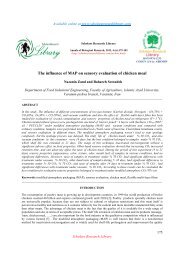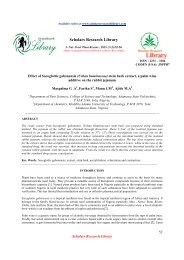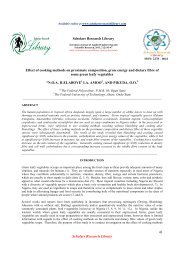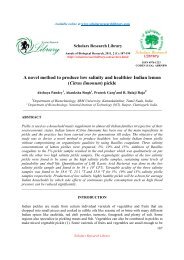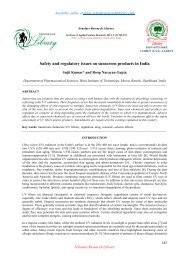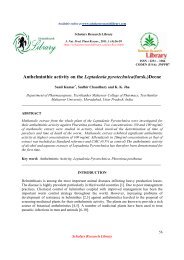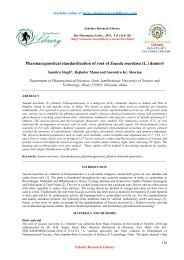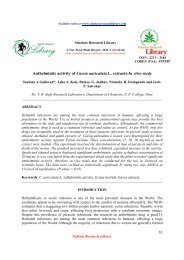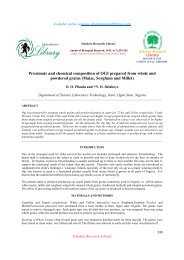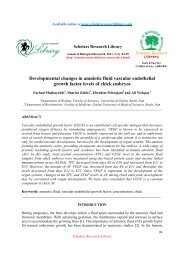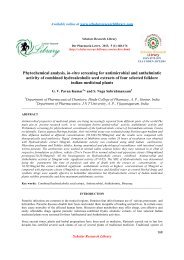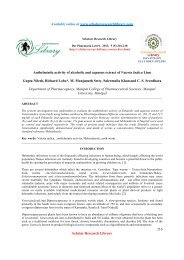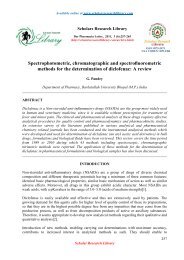The effect of 10 weeks physical activity on job satisfaction of ...
The effect of 10 weeks physical activity on job satisfaction of ...
The effect of 10 weeks physical activity on job satisfaction of ...
You also want an ePaper? Increase the reach of your titles
YUMPU automatically turns print PDFs into web optimized ePapers that Google loves.
Available <strong>on</strong>line at www.scholarsresearchlibrary.com<br />
Scholars Research Library<br />
Annals <str<strong>on</strong>g>of</str<strong>on</strong>g> Biological Research, 2013, 4 (6):254-259<br />
(http://scholarsresearchlibrary.com/archive.html)<br />
ISSN 0976-1233<br />
CODEN (USA): ABRNBW<br />
<str<strong>on</strong>g>The</str<strong>on</strong>g> <str<strong>on</strong>g>effect</str<strong>on</strong>g> <str<strong>on</strong>g>of</str<strong>on</strong>g> <str<strong>on</strong>g>10</str<strong>on</strong>g> <str<strong>on</strong>g>weeks</str<strong>on</strong>g> <str<strong>on</strong>g>physical</str<strong>on</strong>g> <str<strong>on</strong>g>activity</str<strong>on</strong>g> <strong>on</strong> <strong>job</strong> satisfacti<strong>on</strong> <str<strong>on</strong>g>of</str<strong>on</strong>g> university n<strong>on</strong>-athlete<br />
male staffs<br />
Mahvash. Noorbakhsh 1 * and Shahpour. Ghanbari 2<br />
1 College <str<strong>on</strong>g>of</str<strong>on</strong>g> Physical Educati<strong>on</strong> and Sport Sciences, Islamic Azad University, Karaj Branch, Karaj, Iran<br />
2 College <str<strong>on</strong>g>of</str<strong>on</strong>g> Physical Educati<strong>on</strong> and Sport Sciences, Islamic Azad University, Saveh Branch, Saveh, Iran<br />
_____________________________________________________________________________________________<br />
ABSTRACT<br />
<str<strong>on</strong>g>The</str<strong>on</strong>g> state <str<strong>on</strong>g>of</str<strong>on</strong>g> <strong>job</strong> satisfacti<strong>on</strong> c<strong>on</strong>diti<strong>on</strong> <str<strong>on</strong>g>of</str<strong>on</strong>g> university’s staff is <str<strong>on</strong>g>of</str<strong>on</strong>g> high significance as they have a key role in training<br />
the future specialist's workforce in the country. Many researchers suggest that there is a direct relati<strong>on</strong>ship between<br />
<str<strong>on</strong>g>physical</str<strong>on</strong>g> <str<strong>on</strong>g>activity</str<strong>on</strong>g> and <strong>job</strong> satisfacti<strong>on</strong> <str<strong>on</strong>g>of</str<strong>on</strong>g> the people. <str<strong>on</strong>g>The</str<strong>on</strong>g> purpose <str<strong>on</strong>g>of</str<strong>on</strong>g> this research was to find the <str<strong>on</strong>g>effect</str<strong>on</strong>g> <str<strong>on</strong>g>of</str<strong>on</strong>g> a <str<strong>on</strong>g>10</str<strong>on</strong>g>-<br />
<str<strong>on</strong>g>weeks</str<strong>on</strong>g><str<strong>on</strong>g>physical</str<strong>on</strong>g> <str<strong>on</strong>g>activity</str<strong>on</strong>g> <strong>on</strong> <strong>job</strong> satisfacti<strong>on</strong> <str<strong>on</strong>g>of</str<strong>on</strong>g> n<strong>on</strong>-athlete male staff, working at university. <str<strong>on</strong>g>The</str<strong>on</strong>g> research populati<strong>on</strong><br />
c<strong>on</strong>sisted <str<strong>on</strong>g>of</str<strong>on</strong>g> the whole n<strong>on</strong>-athlete male staff, working at university in 20<str<strong>on</strong>g>10</str<strong>on</strong>g> (N=181). A demographic questi<strong>on</strong>naire<br />
as well as a <strong>job</strong> satisfacti<strong>on</strong> questi<strong>on</strong>naire (JDI) was used as measurement tools for the study. Sixty n<strong>on</strong>-athlete<br />
staffs were randomly selected and divided into two groups, namely experimental and c<strong>on</strong>trol groups. <str<strong>on</strong>g>The</str<strong>on</strong>g><br />
experimental group participated in selective <str<strong>on</strong>g>physical</str<strong>on</strong>g> activities for <str<strong>on</strong>g>10</str<strong>on</strong>g> <str<strong>on</strong>g>weeks</str<strong>on</strong>g>, 3 times a week, and <strong>on</strong>e hour in each<br />
sessi<strong>on</strong>. After <str<strong>on</strong>g>10</str<strong>on</strong>g>-<str<strong>on</strong>g>weeks</str<strong>on</strong>g>, the questi<strong>on</strong>naires were given to both groups as post-test. <str<strong>on</strong>g>The</str<strong>on</strong>g> descriptive and inferential<br />
statistics, including independent-t and dependent-t tests were used to find if the group's differences were significant<br />
(α < 0.05). Results showed that there were significant differences between <strong>job</strong> satisfacti<strong>on</strong> and satisfacti<strong>on</strong> from the<br />
<strong>job</strong> nature and satisfacti<strong>on</strong> from the colleagues dimensi<strong>on</strong>s. <str<strong>on</strong>g>The</str<strong>on</strong>g> study also showed that the <str<strong>on</strong>g>physical</str<strong>on</strong>g> <str<strong>on</strong>g>activity</str<strong>on</strong>g> plays a<br />
key role in staff’s <strong>job</strong> satisfacti<strong>on</strong> promoti<strong>on</strong>.<br />
Key words: <str<strong>on</strong>g>physical</str<strong>on</strong>g> activities, Job satisfacti<strong>on</strong>, N<strong>on</strong>-athlete staff.<br />
_____________________________________________________________________________________________<br />
INTRODUCTION<br />
Many behavioral scientists believe that organizati<strong>on</strong>s forman undeniable facet <str<strong>on</strong>g>of</str<strong>on</strong>g> today's modern world. <str<strong>on</strong>g>The</str<strong>on</strong>g> nature<br />
<str<strong>on</strong>g>of</str<strong>on</strong>g> societies is formed by organizati<strong>on</strong>s and existing relati<strong>on</strong>s in world around them.Although organizati<strong>on</strong>s are<br />
established and organized in various forms and based <strong>on</strong> various objectives, all are undoubtedly managed and led<br />
based <strong>on</strong> mental and <str<strong>on</strong>g>physical</str<strong>on</strong>g> labor efforts that are c<strong>on</strong>sidered as their major element (11).No organizati<strong>on</strong> can<br />
achieve a high degree <str<strong>on</strong>g>of</str<strong>on</strong>g> efficiency, flexibility and adaptability.Unless it is benefited from the assistance and help <str<strong>on</strong>g>of</str<strong>on</strong>g><br />
vivid and healthy individuals, so the <str<strong>on</strong>g>physical</str<strong>on</strong>g> educati<strong>on</strong> and exercise play a c<strong>on</strong>structive role in health <str<strong>on</strong>g>of</str<strong>on</strong>g> the society,<br />
exhilarati<strong>on</strong> and vitality <str<strong>on</strong>g>of</str<strong>on</strong>g> the community, developing talents and increasing life expectancy (4).<br />
Human resources are the most important sourcesam<strong>on</strong>g sources <str<strong>on</strong>g>of</str<strong>on</strong>g> organizati<strong>on</strong>s (1). In fact, the most important<br />
success factor in any organizati<strong>on</strong> is to have healthy, committed and loyal employees.Couls<strong>on</strong> et al (2008) c<strong>on</strong>sider<br />
success in the competitive world bel<strong>on</strong>ging to organizati<strong>on</strong>s which regard committed and loyal employees as their<br />
greatest asset and believe that human resources are the <strong>on</strong>ly competitive advantage that organizati<strong>on</strong>s must c<strong>on</strong>vert<br />
this potential force to the actual force through appropriate and proper measures and also c<strong>on</strong>duct them toward<br />
organizati<strong>on</strong>'s goals while creating motivati<strong>on</strong> (7).<br />
Withrespect to observing the principles <str<strong>on</strong>g>of</str<strong>on</strong>g> mental health in the workplace, <strong>on</strong>e <str<strong>on</strong>g>of</str<strong>on</strong>g> the momentous managers' tasks is<br />
to provide necessary and sufficient c<strong>on</strong>diti<strong>on</strong>s and facilities for promoting <strong>job</strong>-satisfacti<strong>on</strong> am<strong>on</strong>g the staffs.Creating<br />
Scholars Research Library<br />
254
Mahvash. Noorbakhsh et al Annals <str<strong>on</strong>g>of</str<strong>on</strong>g> Biological Research, 2013, 4 (6):254-259<br />
_____________________________________________________________________________<br />
favorable human relati<strong>on</strong>s and <strong>job</strong>-satisfacti<strong>on</strong> am<strong>on</strong>g the organizati<strong>on</strong>'s individuals is a serious task that must be<br />
seriously c<strong>on</strong>sidered by managers.Since, recognizingand making healthy human relati<strong>on</strong>s are c<strong>on</strong>sidered as an<br />
<str<strong>on</strong>g>effect</str<strong>on</strong>g>ive factor in achieving objectives and success <str<strong>on</strong>g>of</str<strong>on</strong>g> any organizati<strong>on</strong>.Job-satisfacti<strong>on</strong> is <strong>on</strong>e <str<strong>on</strong>g>of</str<strong>on</strong>g> the<br />
important attitudes having a very high positi<strong>on</strong> in the organizati<strong>on</strong>al behavior studies and is <strong>on</strong>e<str<strong>on</strong>g>of</str<strong>on</strong>g> the most<br />
important factors in <strong>job</strong> success that leadsto increase the efficiency and also feeling <str<strong>on</strong>g>of</str<strong>on</strong>g> pers<strong>on</strong>al satisfacti<strong>on</strong> (9).Jobsatisfacti<strong>on</strong><br />
refers to the general attitude <str<strong>on</strong>g>of</str<strong>on</strong>g> individual <strong>on</strong> his <strong>job</strong>.In <strong>job</strong>- satisfacti<strong>on</strong>, the dimensi<strong>on</strong>s <str<strong>on</strong>g>of</str<strong>on</strong>g> feeling<br />
towards <strong>job</strong> nature, management, colleagues, enhancement and promoti<strong>on</strong> and rights and benefits are studied (12).A<br />
pers<strong>on</strong>, whose <strong>job</strong>-satisfacti<strong>on</strong> is at a high level, has a positive attitude toward his work while for <strong>on</strong>e who is<br />
unhappy with his <strong>job</strong>; his attitude toward his work is negative. Generally, <strong>job</strong>-satisfacti<strong>on</strong> causesto increase in the<br />
individual productivity, to undertake a pers<strong>on</strong> to organizati<strong>on</strong>, to ensure his <str<strong>on</strong>g>physical</str<strong>on</strong>g> and mental health, to improve<br />
individual's moodand to have life satisfacti<strong>on</strong> and to be quickly trained for new <strong>job</strong> skills. However, the lack <str<strong>on</strong>g>of</str<strong>on</strong>g> <strong>job</strong>satisfacti<strong>on</strong><br />
leads to reduce staff's morale that the issue is highly undesirable in doing administrative duties (1).Over<br />
the past few years, ec<strong>on</strong>omists have shown much interest in <strong>job</strong>- and life satisfacti<strong>on</strong>. Also, issues related to the <strong>job</strong><br />
and life satisfacti<strong>on</strong> and general and <str<strong>on</strong>g>physical</str<strong>on</strong>g> labor health are important for employers and policy-makers.Those who<br />
are satisfied with their <strong>job</strong> in more difficult work circumstances are less likely to leave their <strong>job</strong> and individuals with<br />
high general and <str<strong>on</strong>g>physical</str<strong>on</strong>g> health level have greater ability to do things (3).<br />
Research results have shown that <str<strong>on</strong>g>physical</str<strong>on</strong>g> exercise and activities have a positive <str<strong>on</strong>g>effect</str<strong>on</strong>g> <strong>on</strong> general health and<br />
according to the c<strong>on</strong>ducted studies, there is a positive attitude between <str<strong>on</strong>g>physical</str<strong>on</strong>g> <str<strong>on</strong>g>activity</str<strong>on</strong>g> and body image andthe<br />
satisfacti<strong>on</strong> resulted from <str<strong>on</strong>g>physical</str<strong>on</strong>g> <str<strong>on</strong>g>activity</str<strong>on</strong>g> causes pleasure and satisfacti<strong>on</strong> in the life and this may be spread in other<br />
aspects <str<strong>on</strong>g>of</str<strong>on</strong>g> life (2) while the results <str<strong>on</strong>g>of</str<strong>on</strong>g> the research byCarraca (2012) showed that there was no significant<br />
relati<strong>on</strong>ship between body image and <str<strong>on</strong>g>physical</str<strong>on</strong>g> <str<strong>on</strong>g>activity</str<strong>on</strong>g> (6).Researches have indicated that regular <str<strong>on</strong>g>physical</str<strong>on</strong>g> activities<br />
cause to promote general and <str<strong>on</strong>g>physical</str<strong>on</strong>g> health and also directly assist employers through increasing the <strong>job</strong>satisfacti<strong>on</strong><br />
<str<strong>on</strong>g>of</str<strong>on</strong>g> staffs and <str<strong>on</strong>g>effect</str<strong>on</strong>g>iveness and efficiency <str<strong>on</strong>g>of</str<strong>on</strong>g> organizati<strong>on</strong>s (17).<br />
In a study, Shephard&Sifen (2002) showed that individuals who regularly do aerobic exercise have lower rate <str<strong>on</strong>g>of</str<strong>on</strong>g><br />
anxiety and hopelessness, participate more in social activities and have more satisfacti<strong>on</strong> with themselves(14).In a<br />
study, Bruce (20<str<strong>on</strong>g>10</str<strong>on</strong>g>) showed that there was a direct relati<strong>on</strong>ship between exercise and <strong>job</strong>-satisfacti<strong>on</strong>(5). Wattles &<br />
Harris (2003) c<strong>on</strong>cluded that <strong>job</strong>-satisfacti<strong>on</strong> has a positive and significant correlati<strong>on</strong> with cardio-vascular<br />
endurance and a high level <str<strong>on</strong>g>of</str<strong>on</strong>g> some fitness factors positively <str<strong>on</strong>g>effect</str<strong>on</strong>g>s <strong>on</strong> absenteeism, <strong>job</strong>-satisfacti<strong>on</strong> and<br />
efficiency(18).Ohta, Takigami& Ikeda (2007) indicated that the <strong>job</strong>-satisfacti<strong>on</strong> level <str<strong>on</strong>g>of</str<strong>on</strong>g> workers increased through<br />
participating in aerobic exercise.In a research(13), Thogers<strong>on</strong>-Ntoumani& Fox (2005) showed that <str<strong>on</strong>g>physical</str<strong>on</strong>g><br />
activities had a direct relati<strong>on</strong> with <strong>job</strong>-satisfacti<strong>on</strong> in various levels while Defenbaugh(2011) observed no<br />
significant relati<strong>on</strong>ship between <str<strong>on</strong>g>physical</str<strong>on</strong>g> <str<strong>on</strong>g>activity</str<strong>on</strong>g> and <strong>job</strong>-satisfacti<strong>on</strong>(8,16).<br />
In a study, Todd (2009) indicated that because <str<strong>on</strong>g>of</str<strong>on</strong>g>raising employees' self-esteem, the social identity resulted from<br />
employing individual in exercise cause to increase <strong>job</strong>-satisfacti<strong>on</strong> and also the social identity resulted from the<br />
workplace cause to increase individual returns such as organizati<strong>on</strong>al commitment, <strong>job</strong>-satisfacti<strong>on</strong> and participating<br />
in work based <strong>on</strong> the attitudepower(15).Beiruti (2011) emphasizes the necessity <str<strong>on</strong>g>of</str<strong>on</strong>g> incorporating <str<strong>on</strong>g>physical</str<strong>on</strong>g> <str<strong>on</strong>g>activity</str<strong>on</strong>g> in<br />
<strong>job</strong> activities <str<strong>on</strong>g>of</str<strong>on</strong>g> staffs and states that <str<strong>on</strong>g>physical</str<strong>on</strong>g> activities lead to staffs' health and ultimately greater organizati<strong>on</strong><br />
efficiency.He also emphasizes that if managers want to participate their staffs in exercise, they should use incentives<br />
causing to encourage staffs in <str<strong>on</strong>g>physical</str<strong>on</strong>g> activities (4,).<br />
Low work, lack <str<strong>on</strong>g>of</str<strong>on</strong>g> resp<strong>on</strong>sibility, overt or covert oppositi<strong>on</strong> with management and organizati<strong>on</strong>al program and<br />
misunderstandings with colleagues are reduced by increasing <strong>job</strong>-satisfacti<strong>on</strong>. Through delineating the relati<strong>on</strong>ship<br />
between <str<strong>on</strong>g>physical</str<strong>on</strong>g> <str<strong>on</strong>g>activity</str<strong>on</strong>g> and <strong>job</strong>-satisfacti<strong>on</strong>, we can take further step for identifying sources creating <strong>job</strong>satisfacti<strong>on</strong><br />
and factors affecting the studied society.Despite extensive research <strong>on</strong> factors influencing <strong>job</strong>satisfacti<strong>on</strong><br />
and also the tremendous influence <str<strong>on</strong>g>of</str<strong>on</strong>g> <str<strong>on</strong>g>physical</str<strong>on</strong>g> <str<strong>on</strong>g>activity</str<strong>on</strong>g> <strong>on</strong> various aspects <str<strong>on</strong>g>of</str<strong>on</strong>g> individuals' lives,little<br />
attenti<strong>on</strong> has empirically been paidto the <str<strong>on</strong>g>effect</str<strong>on</strong>g> <str<strong>on</strong>g>of</str<strong>on</strong>g> exercise and <str<strong>on</strong>g>physical</str<strong>on</strong>g> <str<strong>on</strong>g>activity</str<strong>on</strong>g> <strong>on</strong> <strong>job</strong>-satisfacti<strong>on</strong>.C<strong>on</strong>sidering the<br />
agreed and disagreed findings and menti<strong>on</strong>ed cases, should studying the status and <strong>job</strong>-satisfacti<strong>on</strong> <str<strong>on</strong>g>of</str<strong>on</strong>g> university's<br />
staffs seriously be c<strong>on</strong>sidered as <strong>on</strong>e <str<strong>on</strong>g>of</str<strong>on</strong>g> pillars in developing human society and the influence and importance <str<strong>on</strong>g>of</str<strong>on</strong>g> this<br />
social class <strong>on</strong> training future specialists. Accordingly, the present study aimed to evaluate the <str<strong>on</strong>g>effect</str<strong>on</strong>g> <str<strong>on</strong>g>of</str<strong>on</strong>g> <str<strong>on</strong>g>10</str<strong>on</strong>g>-week<br />
selective exercise <strong>on</strong> the <strong>job</strong>-satisfacti<strong>on</strong> <str<strong>on</strong>g>of</str<strong>on</strong>g> n<strong>on</strong>-athlete male staffs working at the university.So, the researcher seeks<br />
to find out:in which level is the <strong>job</strong>-satisfacti<strong>on</strong> <str<strong>on</strong>g>of</str<strong>on</strong>g> staffs working at the university. Have exercise and <str<strong>on</strong>g>physical</str<strong>on</strong>g><br />
activities any <str<strong>on</strong>g>effect</str<strong>on</strong>g> <strong>on</strong> dimensi<strong>on</strong>s <str<strong>on</strong>g>of</str<strong>on</strong>g> <strong>job</strong>-satisfacti<strong>on</strong> <str<strong>on</strong>g>of</str<strong>on</strong>g> staffs in the organizati<strong>on</strong>?<br />
MATERIALS AND METHODS<br />
Research methodology<br />
<str<strong>on</strong>g>The</str<strong>on</strong>g> research method is semi-empirical d<strong>on</strong>e as field and using pre-test and post-test.<br />
Scholars Research Library<br />
255
Mahvash. Noorbakhsh et al Annals <str<strong>on</strong>g>of</str<strong>on</strong>g> Biological Research, 2013, 4 (6):254-259<br />
_____________________________________________________________________________<br />
Statistical sample and populati<strong>on</strong><br />
<str<strong>on</strong>g>The</str<strong>on</strong>g> statistical populati<strong>on</strong> <str<strong>on</strong>g>of</str<strong>on</strong>g> the research c<strong>on</strong>sist <str<strong>on</strong>g>of</str<strong>on</strong>g> all n<strong>on</strong>-athlete university male staffs who have been working in<br />
20<str<strong>on</strong>g>10</str<strong>on</strong>g> (N= 181).To select the samples for the present study, while expressing the c<strong>on</strong>sent for participating in the<br />
study, first, staffs filled the research questi<strong>on</strong>naires.Out <str<strong>on</strong>g>of</str<strong>on</strong>g> the collected questi<strong>on</strong>naires, 60 n<strong>on</strong>-athletic staffs; in<br />
other words, those who have no regular <str<strong>on</strong>g>physical</str<strong>on</strong>g> activities over the past 2 years were randomly selected and divided<br />
into the experimental and c<strong>on</strong>trol groups.<br />
Measurement tools<br />
<str<strong>on</strong>g>The</str<strong>on</strong>g> following tools and instruments were used to collect informati<strong>on</strong> and data:<br />
1- Wysocki and Krumm <strong>job</strong>-satisfacti<strong>on</strong> questi<strong>on</strong>naire (1994)<br />
2- <str<strong>on</strong>g>The</str<strong>on</strong>g> questi<strong>on</strong>naire<str<strong>on</strong>g>of</str<strong>on</strong>g> pers<strong>on</strong>al features<br />
3- Polar Stethoscope<br />
JDI questi<strong>on</strong>naire which has high reliability and validity has so far been used by many researchers. In the current<br />
study, the validity <str<strong>on</strong>g>of</str<strong>on</strong>g> the menti<strong>on</strong>ed questi<strong>on</strong>naire was calculated by Cr<strong>on</strong>bach's alpha method using SPSS s<str<strong>on</strong>g>of</str<strong>on</strong>g>tware<br />
and obtained as 0.93.<br />
<str<strong>on</strong>g>The</str<strong>on</strong>g> questi<strong>on</strong>naire <str<strong>on</strong>g>of</str<strong>on</strong>g> pers<strong>on</strong>al informati<strong>on</strong> includes age, marital status, work experience, level <str<strong>on</strong>g>of</str<strong>on</strong>g> educati<strong>on</strong>,<br />
employment status, educati<strong>on</strong>al field <str<strong>on</strong>g>of</str<strong>on</strong>g> study, and the athletic history <str<strong>on</strong>g>of</str<strong>on</strong>g> staffs.<br />
<str<strong>on</strong>g>The</str<strong>on</strong>g> method <str<strong>on</strong>g>of</str<strong>on</strong>g> collecting data<br />
In order tocollect data, while explaining the research objectives by the researcher,the research questi<strong>on</strong>naires were<br />
distributed am<strong>on</strong>g all university male staffs.Am<strong>on</strong>g the collected questi<strong>on</strong>naires, it was specified that 181<br />
individuals were n<strong>on</strong>-athletic staffs; in other words, they have had no regular <str<strong>on</strong>g>physical</str<strong>on</strong>g> activities over the past 2<br />
years.Am<strong>on</strong>g from thisgroup, 60 individuals were randomly selected and divided into two experimental (N = 30)<br />
and c<strong>on</strong>trol (N = 30) groups. <str<strong>on</strong>g>The</str<strong>on</strong>g> experimental group participated in selective <str<strong>on</strong>g>physical</str<strong>on</strong>g> exercises for <str<strong>on</strong>g>10</str<strong>on</strong>g> <str<strong>on</strong>g>weeks</str<strong>on</strong>g>, 3<br />
times a week, and <strong>on</strong>e hour in each sessi<strong>on</strong>.In the present study, the program for <str<strong>on</strong>g>physical</str<strong>on</strong>g> exercise was: 1- Warm-up<br />
including walking, jogging, stretching movements and various s<str<strong>on</strong>g>of</str<strong>on</strong>g>tened movements for 20 min, 2- c<strong>on</strong>tinuous<br />
running with the intensity <str<strong>on</strong>g>of</str<strong>on</strong>g> 60-70% <str<strong>on</strong>g>of</str<strong>on</strong>g> maximum heart rate for 20 to 30 minutes.<br />
Given increasingly being exercise protocol, this part <str<strong>on</strong>g>of</str<strong>on</strong>g> the exercise begin with the intensity <str<strong>on</strong>g>of</str<strong>on</strong>g> 60% maximum heart<br />
rate <str<strong>on</strong>g>of</str<strong>on</strong>g> subjective for 20 minutes and gradually increases to 70% <str<strong>on</strong>g>of</str<strong>on</strong>g> maximum heart rate for 30 minutes (the exercise<br />
was performed with the intensity <str<strong>on</strong>g>of</str<strong>on</strong>g> 60%,65% and 70% maximum heart rate in the first 3 <str<strong>on</strong>g>weeks</str<strong>on</strong>g>, in the sec<strong>on</strong>d 3<br />
<str<strong>on</strong>g>weeks</str<strong>on</strong>g> and the next four <str<strong>on</strong>g>weeks</str<strong>on</strong>g>, respectively and also, every week added <strong>on</strong>e minute to the jogging time).3- warmdown<br />
including walking, slow jogging and stretching movements for 15 minutes. After <str<strong>on</strong>g>10</str<strong>on</strong>g>-week exercise, the<br />
research questi<strong>on</strong>naires were again distributed and collected to take post-test am<strong>on</strong>g the experimental and c<strong>on</strong>trol<br />
groups.Data obtained from questi<strong>on</strong>naires in two stages were collected, coded and entered into the computer and<br />
analyzed using SPSS s<str<strong>on</strong>g>of</str<strong>on</strong>g>tware in two descriptive and inferential parts.<br />
Statistical Methods<br />
Two following statistical methods have been used to test hypotheses and classify and analyze the collected data.<str<strong>on</strong>g>The</str<strong>on</strong>g><br />
descriptive statistics has been used <strong>on</strong> absolute frequency, frequency percentage and cumulative frequency<br />
percentage, table <str<strong>on</strong>g>of</str<strong>on</strong>g> frequency distributi<strong>on</strong> and graphs <str<strong>on</strong>g>of</str<strong>on</strong>g> mean and standard deviati<strong>on</strong>.<str<strong>on</strong>g>The</str<strong>on</strong>g> inferential statistics,<br />
dependent-t test, and independent-t test have been used to test research hypothesis andtoexamine the <str<strong>on</strong>g>effect</str<strong>on</strong>g> <str<strong>on</strong>g>of</str<strong>on</strong>g><br />
exercise for the difference between groups, respectively.<br />
RESULTS<br />
<str<strong>on</strong>g>The</str<strong>on</strong>g> research findings showed that about 70% <str<strong>on</strong>g>of</str<strong>on</strong>g> workers are in the age range <str<strong>on</strong>g>of</str<strong>on</strong>g> 31 to 40 years. 93% <str<strong>on</strong>g>of</str<strong>on</strong>g> staffs are<br />
married. 38% <str<strong>on</strong>g>of</str<strong>on</strong>g> staffs have the working history <str<strong>on</strong>g>of</str<strong>on</strong>g> 11 to 15 years and 48% have undergraduate educati<strong>on</strong> and 93%<br />
<str<strong>on</strong>g>of</str<strong>on</strong>g> staffs participated in the study were formally working.<br />
Findings indicate that the mean scores <str<strong>on</strong>g>of</str<strong>on</strong>g> "salary payment", " supervisor " and "promoti<strong>on</strong>" comp<strong>on</strong>entsare almost<br />
identical in the pre- and post-test in the experimental and c<strong>on</strong>trol groups; however, in the post-test, scores <str<strong>on</strong>g>of</str<strong>on</strong>g> "nature<br />
<str<strong>on</strong>g>of</str<strong>on</strong>g> the work", "colleague" and "total <strong>job</strong>-satisfacti<strong>on</strong>" <str<strong>on</strong>g>of</str<strong>on</strong>g> staffs in the experimental group have been increased<br />
compared with those in the c<strong>on</strong>trol group.<br />
In the experimental and c<strong>on</strong>trol groups, the lowest rate <str<strong>on</strong>g>of</str<strong>on</strong>g> scattering in "pre-test" and "post-test" is related to the<br />
"salary payment" while in both groups, "satisfacti<strong>on</strong> with colleague " has the highest dispersi<strong>on</strong>.<br />
Scholars Research Library<br />
256
Mahvash. Noorbakhsh et al Annals <str<strong>on</strong>g>of</str<strong>on</strong>g> Biological Research, 2013, 4 (6):254-259<br />
_____________________________________________________________________________<br />
In thissecti<strong>on</strong>, the rate <str<strong>on</strong>g>of</str<strong>on</strong>g> the <str<strong>on</strong>g>effect</str<strong>on</strong>g> <str<strong>on</strong>g>of</str<strong>on</strong>g> <str<strong>on</strong>g>physical</str<strong>on</strong>g> <str<strong>on</strong>g>activity</str<strong>on</strong>g> is studied by doing the dependent-t test between pre-test and<br />
post-test <str<strong>on</strong>g>of</str<strong>on</strong>g> the experimental group.<br />
Table 1: the mean and standard deviati<strong>on</strong> <str<strong>on</strong>g>of</str<strong>on</strong>g> <strong>job</strong>-satisfacti<strong>on</strong> in the experimental and c<strong>on</strong>trol groups (N=60)<br />
comp<strong>on</strong>ent Experimental group (N=30) C<strong>on</strong>trol group (N=30)<br />
M SD MSD<br />
Job<br />
Pretest 31.13 6.3<br />
31.47 6.2<br />
Pretest 33.43 6.3<br />
31.87 7<br />
Salary payment<br />
Pretest 15.63 5.2<br />
16.27 4.8<br />
Pretest 15.93 4.9<br />
16.67 4.8<br />
Colleague<br />
Pretest 30.27 7.4<br />
29.7 6.6<br />
Pretest 33.43 7.3<br />
30.23 6.1<br />
Supervisor<br />
Pretest 25.57 6.7<br />
25.2 6.1<br />
Pretest 26.23 6.5<br />
25. 3 6.3<br />
Way <str<strong>on</strong>g>of</str<strong>on</strong>g> Promoti<strong>on</strong><br />
Pretest 15.13 7.1<br />
14.97 5.8<br />
Pretest 15.87 7<br />
15.2 5.5<br />
Total (<strong>job</strong>-satisfacti<strong>on</strong>)<br />
Pretest 117.73 23.14<br />
117.6 18.8<br />
Pretest 124.53 21.8<br />
119.27 18.9<br />
Table 2: <str<strong>on</strong>g>The</str<strong>on</strong>g> dependent-t test for comparing pre-test and post-test scores <str<strong>on</strong>g>of</str<strong>on</strong>g> <strong>job</strong>-satisfacti<strong>on</strong> in the experimental group<br />
comp<strong>on</strong>ent<br />
Job -satisfacti<strong>on</strong><br />
Payment-satisfacti<strong>on</strong><br />
Colleague- satisfacti<strong>on</strong><br />
Supervisor- satisfacti<strong>on</strong><br />
Promoti<strong>on</strong>-satisfacti<strong>on</strong><br />
Total <str<strong>on</strong>g>of</str<strong>on</strong>g> <strong>job</strong>-satisfacti<strong>on</strong><br />
Number<br />
30<br />
30<br />
30<br />
30<br />
30<br />
30<br />
Mean<br />
-2.3<br />
-0.3<br />
-3.16<br />
-0.7<br />
-0.73<br />
-6.8<br />
SD<br />
2.98<br />
3.2<br />
3.5<br />
2.2<br />
1.9<br />
8.2<br />
DF<br />
29<br />
29<br />
29<br />
29<br />
29<br />
29<br />
Observed t value<br />
-4.22<br />
-0.52<br />
-4.98<br />
-1.7<br />
-2.2<br />
-4.5<br />
Level <str<strong>on</strong>g>of</str<strong>on</strong>g> Significance<br />
0.01<br />
0.6<br />
0.01<br />
0.1<br />
0.04<br />
0.01<br />
As it is seen in the above table, the obtained t is significant at the 0.01 level in "<strong>job</strong>-satisfacti<strong>on</strong>", "colleaguesatisfacti<strong>on</strong>"<br />
and "total <str<strong>on</strong>g>of</str<strong>on</strong>g> <strong>job</strong>-satisfacti<strong>on</strong>" comp<strong>on</strong>ents and at 0.04 in the "promoti<strong>on</strong>-satisfacti<strong>on</strong>" <strong>on</strong>e.In other<br />
words, in these comp<strong>on</strong>ents, the scores <str<strong>on</strong>g>of</str<strong>on</strong>g> subjects' post-test has been significantly increased compared with the pretest.<br />
<str<strong>on</strong>g>The</str<strong>on</strong>g>refore, it can be c<strong>on</strong>cluded that doing <str<strong>on</strong>g>physical</str<strong>on</strong>g> activities can raise colleague-satisfacti<strong>on</strong>, promoti<strong>on</strong>satisfacti<strong>on</strong><br />
and total <strong>job</strong>-satisfacti<strong>on</strong> and this is while doing <str<strong>on</strong>g>physical</str<strong>on</strong>g> activities have had no <str<strong>on</strong>g>effect</str<strong>on</strong>g> <strong>on</strong> increasing<br />
payment- and supervisor-satisfacti<strong>on</strong>.<br />
Table 3: Independent-t test for comparing different scores <str<strong>on</strong>g>of</str<strong>on</strong>g> staffs' <strong>job</strong>-satisfacti<strong>on</strong> in the experimental and c<strong>on</strong>trol groups<br />
Groups number mean SD Freedom degree Observed t Significant level<br />
Experimental group 30 6.8 8.2<br />
51/4 2.8 0.01<br />
c<strong>on</strong>trol group 30 1.7 5.6<br />
According to the scores obtained from the above table, the observed t (2.8) is significant at 1% level <str<strong>on</strong>g>of</str<strong>on</strong>g> significance.<br />
So it can be c<strong>on</strong>cluded that <str<strong>on</strong>g>10</str<strong>on</strong>g>-week selective <str<strong>on</strong>g>physical</str<strong>on</strong>g> activities have a significant <str<strong>on</strong>g>effect</str<strong>on</strong>g> <strong>on</strong> the rate <str<strong>on</strong>g>of</str<strong>on</strong>g>staffs' <strong>job</strong>satisfacti<strong>on</strong>.<br />
Table 4: Independent-t test for comparing the different scores <str<strong>on</strong>g>of</str<strong>on</strong>g> the rate<str<strong>on</strong>g>of</str<strong>on</strong>g> satisfacti<strong>on</strong> with comp<strong>on</strong>ents <str<strong>on</strong>g>of</str<strong>on</strong>g> <strong>job</strong>-satisfacti<strong>on</strong> in the<br />
experimental and c<strong>on</strong>trol groups<br />
Groups<br />
Experimental group<br />
Nature <str<strong>on</strong>g>of</str<strong>on</strong>g> work<br />
C<strong>on</strong>trol group<br />
Managers (Supervisi<strong>on</strong>)<br />
Experi. group<br />
C<strong>on</strong>trol group<br />
Co-workers<br />
Experi. group<br />
C<strong>on</strong>trol group<br />
Promoti<strong>on</strong>al opportunities<br />
Experi. group<br />
C<strong>on</strong>trol group<br />
Pay Satisfacti<strong>on</strong><br />
Experi. group<br />
C<strong>on</strong>trol group<br />
No.<br />
30<br />
30<br />
30<br />
30<br />
30<br />
30<br />
30<br />
30<br />
30<br />
30<br />
Mean<br />
2.3<br />
0.4<br />
0.67<br />
0.1<br />
3.2<br />
0.53<br />
0.73<br />
0.23<br />
0.3<br />
0.4<br />
SD.<br />
2.98<br />
3.1<br />
2.2<br />
1.7<br />
3.5<br />
2.2<br />
1.86<br />
1.94<br />
3.15<br />
2.7<br />
df.<br />
58<br />
58<br />
58<br />
58<br />
58<br />
t<br />
2.4<br />
1.1<br />
3.5<br />
1.02<br />
-0.13<br />
P-Values<br />
0.019<br />
0.26<br />
0.01<br />
0.31<br />
0.89<br />
Scholars Research Library<br />
257
Mahvash. Noorbakhsh et al Annals <str<strong>on</strong>g>of</str<strong>on</strong>g> Biological Research, 2013, 4 (6):254-259<br />
_____________________________________________________________________________<br />
As it can be observed, the satisfacti<strong>on</strong> <str<strong>on</strong>g>of</str<strong>on</strong>g> "nature <str<strong>on</strong>g>of</str<strong>on</strong>g> work"comp<strong>on</strong>ent is significant at the level <str<strong>on</strong>g>of</str<strong>on</strong>g> 0.05. <str<strong>on</strong>g>The</str<strong>on</strong>g>refore,it<br />
can be c<strong>on</strong>cluded that <str<strong>on</strong>g>10</str<strong>on</strong>g>-week selective <str<strong>on</strong>g>physical</str<strong>on</strong>g> activities has a significant <str<strong>on</strong>g>effect</str<strong>on</strong>g> <strong>on</strong> the rate <str<strong>on</strong>g>of</str<strong>on</strong>g> staffs' feeling<br />
towardthe nature <str<strong>on</strong>g>of</str<strong>on</strong>g> work.<br />
As it is seen in the above table, the comp<strong>on</strong>ent "management- satisfacti<strong>on</strong>" is not significant at the level <str<strong>on</strong>g>of</str<strong>on</strong>g> 0.05. It<br />
cantherefore be said that <str<strong>on</strong>g>10</str<strong>on</strong>g>-week selective <str<strong>on</strong>g>physical</str<strong>on</strong>g> activities has no significant <str<strong>on</strong>g>effect</str<strong>on</strong>g> <strong>on</strong> the rate <str<strong>on</strong>g>of</str<strong>on</strong>g> staffs' feeling<br />
towardmanagement. According to the informati<strong>on</strong> <str<strong>on</strong>g>of</str<strong>on</strong>g> the above-menti<strong>on</strong>ed table and given the observed t (3.5) being<br />
significant at 0.01 level, it can be c<strong>on</strong>cluded that <str<strong>on</strong>g>10</str<strong>on</strong>g>-week selective <str<strong>on</strong>g>physical</str<strong>on</strong>g> activities has a significant <str<strong>on</strong>g>effect</str<strong>on</strong>g> <strong>on</strong> the<br />
rate <str<strong>on</strong>g>of</str<strong>on</strong>g> staffs' feeling toward colleagues.<br />
According to the above table informati<strong>on</strong>, the observed t (02/1) is not significant at 5% level. So it can be said that<br />
<str<strong>on</strong>g>10</str<strong>on</strong>g>-week selective <str<strong>on</strong>g>physical</str<strong>on</strong>g> activities has no significant <str<strong>on</strong>g>effect</str<strong>on</strong>g> <strong>on</strong> the rate <str<strong>on</strong>g>of</str<strong>on</strong>g> staffs' feeling toward the enhancement<br />
and promoti<strong>on</strong>.<br />
Also, based <strong>on</strong> the informati<strong>on</strong> <str<strong>on</strong>g>of</str<strong>on</strong>g> the above table, it is observed that the satisfacti<strong>on</strong> with rights and benefits<br />
payment comp<strong>on</strong>ents is not significant at the level <str<strong>on</strong>g>of</str<strong>on</strong>g> 0.05. So it can be said that <str<strong>on</strong>g>10</str<strong>on</strong>g>-week selective <str<strong>on</strong>g>physical</str<strong>on</strong>g><br />
activities has no significant <str<strong>on</strong>g>effect</str<strong>on</strong>g> <strong>on</strong> the rate <str<strong>on</strong>g>of</str<strong>on</strong>g> staffs' feeling toward the rights and benefits.<br />
DISCUSSION AND CONCLUSION<br />
Comparing the study results with the previous <strong>on</strong>es indicate that the results <str<strong>on</strong>g>of</str<strong>on</strong>g> many studies are c<strong>on</strong>sistent with<br />
theresults obtained from the present study, while a few studies have reached different findings.<br />
<str<strong>on</strong>g>The</str<strong>on</strong>g> results obtained from the present study revealed that <str<strong>on</strong>g>10</str<strong>on</strong>g>-week selective <str<strong>on</strong>g>physical</str<strong>on</strong>g> activities had a significant<br />
<str<strong>on</strong>g>effect</str<strong>on</strong>g> <strong>on</strong> increasing staffs' <strong>job</strong>-satisfacti<strong>on</strong> and dimensi<strong>on</strong>s <str<strong>on</strong>g>of</str<strong>on</strong>g> <strong>job</strong>-satisfacti<strong>on</strong> including nature <str<strong>on</strong>g>of</str<strong>on</strong>g> work-satisfacti<strong>on</strong><br />
and colleagues- satisfacti<strong>on</strong> and also significant <str<strong>on</strong>g>effect</str<strong>on</strong>g> <strong>on</strong> dimensi<strong>on</strong>s <str<strong>on</strong>g>of</str<strong>on</strong>g> <strong>job</strong>-satisfacti<strong>on</strong> including superiorsatisfacti<strong>on</strong>,<br />
promoti<strong>on</strong>- and enhancement- satisfacti<strong>on</strong> and rights and benefits-satisfacti<strong>on</strong>.<br />
<str<strong>on</strong>g>The</str<strong>on</strong>g>se findings are c<strong>on</strong>sistent with findings <str<strong>on</strong>g>of</str<strong>on</strong>g> Bruce (20<str<strong>on</strong>g>10</str<strong>on</strong>g>), Todd (2009), Utah, Takygamy and Aykda (2007),<br />
TvgrsvnAntomany and Fox (2005), Vatls and Harris (2003) who expressed that the <strong>job</strong>-satisfacti<strong>on</strong> improves<br />
through participating individuals in <str<strong>on</strong>g>physical</str<strong>on</strong>g> activities (5, 13, 15, 17 and 18). <str<strong>on</strong>g>The</str<strong>on</strong>g> possible reas<strong>on</strong>s for this<br />
c<strong>on</strong>sistency can be in the similarity between the durati<strong>on</strong> <str<strong>on</strong>g>of</str<strong>on</strong>g> exercise, exercise intensity, exercise type, the number <str<strong>on</strong>g>of</str<strong>on</strong>g><br />
exercise sessi<strong>on</strong>s, the nature <str<strong>on</strong>g>of</str<strong>on</strong>g> exercise protocol and also the fitness level <str<strong>on</strong>g>of</str<strong>on</strong>g> staffs. Exercise and <str<strong>on</strong>g>physical</str<strong>on</strong>g> activities<br />
affect <strong>on</strong> the performance <str<strong>on</strong>g>of</str<strong>on</strong>g> staffs by positively impacting <strong>on</strong> their <str<strong>on</strong>g>physical</str<strong>on</strong>g> and mental status.<br />
Various studies have shown that exercise and increasing the fitness level lead to possible change in mood, decrease<br />
in the <str<strong>on</strong>g>physical</str<strong>on</strong>g> fatigue resulted from increasing work capacity, <str<strong>on</strong>g>physical</str<strong>on</strong>g> diseases, absenteeism in the result <str<strong>on</strong>g>of</str<strong>on</strong>g> the<br />
staffs' general and <str<strong>on</strong>g>physical</str<strong>on</strong>g> health, stress and depressi<strong>on</strong> (Vatls and Harris, 2003) and anxiety, raise c<strong>on</strong>fidence,<br />
enhance a positive self-c<strong>on</strong>cept, socialize, creat sufficiency and skill (Alberta, 2007), increase self-esteem,<br />
participate in the work based <strong>on</strong> the attitude power (Todd, 2009), increase the cardio-vascular endurance resulted<br />
from the less work fatigue and more work focus, raise <strong>on</strong> the <strong>job</strong> fatigue and increase muscular strength in result <str<strong>on</strong>g>of</str<strong>on</strong>g><br />
reducing physiological stress (VatlsVhrys, 2003) and result in increasing <strong>job</strong>-satisfacti<strong>on</strong> (18, 2, 15). <str<strong>on</strong>g>The</str<strong>on</strong>g> research<br />
findings are not c<strong>on</strong>sistent with Karaka's findings (2012) that showed there was no significant relati<strong>on</strong>ship between<br />
<str<strong>on</strong>g>physical</str<strong>on</strong>g> activities and the positive image <str<strong>on</strong>g>of</str<strong>on</strong>g> body and its possible reas<strong>on</strong> can be the difference between populati<strong>on</strong><br />
and the type <str<strong>on</strong>g>of</str<strong>on</strong>g> exercises.<br />
<str<strong>on</strong>g>The</str<strong>on</strong>g> present study is not c<strong>on</strong>sistent with findings <str<strong>on</strong>g>of</str<strong>on</strong>g> Coleman and Byrgyta (2008) who observed no significant<br />
difference between staffs' <strong>job</strong>-satisfacti<strong>on</strong> and active and n<strong>on</strong>-active faculty members in exercise.<str<strong>on</strong>g>The</str<strong>on</strong>g>se differences<br />
can probably be due to the way <str<strong>on</strong>g>of</str<strong>on</strong>g> exercises and lack <str<strong>on</strong>g>of</str<strong>on</strong>g> significant difference between staffs' <str<strong>on</strong>g>physical</str<strong>on</strong>g> fitness and<br />
active and n<strong>on</strong>-active faculty members in <str<strong>on</strong>g>physical</str<strong>on</strong>g> activities in different studied communities.In the present study,<br />
the <str<strong>on</strong>g>effect</str<strong>on</strong>g> <str<strong>on</strong>g>of</str<strong>on</strong>g> selective <str<strong>on</strong>g>physical</str<strong>on</strong>g> activities including aerobic activities <strong>on</strong> both experimental and c<strong>on</strong>trol groups was<br />
studied while Coleman and Byrgyta (2008) collected the rate <str<strong>on</strong>g>of</str<strong>on</strong>g> <str<strong>on</strong>g>physical</str<strong>on</strong>g> activities <str<strong>on</strong>g>of</str<strong>on</strong>g> staffs and faculty members by<br />
questi<strong>on</strong>naire and c<strong>on</strong>cluded that there was no significant difference between the <strong>job</strong>- satisfacti<strong>on</strong> <str<strong>on</strong>g>of</str<strong>on</strong>g> active and n<strong>on</strong>active<br />
staffs and faculty members in <str<strong>on</strong>g>physical</str<strong>on</strong>g> activities (<str<strong>on</strong>g>10</str<strong>on</strong>g>).<br />
Generally, the findings <str<strong>on</strong>g>of</str<strong>on</strong>g> most studies associated with the present topic indicated that <str<strong>on</strong>g>physical</str<strong>on</strong>g> activities particularly<br />
aerobic exercise have had a significant influence <strong>on</strong> the <strong>job</strong>-satisfacti<strong>on</strong>. Also, the results obtained from the present<br />
study showed that <str<strong>on</strong>g>10</str<strong>on</strong>g>-week selective activities including aerobic exercises has a positive <str<strong>on</strong>g>effect</str<strong>on</strong>g> <strong>on</strong> the satisfacti<strong>on</strong><br />
dimensi<strong>on</strong>s <str<strong>on</strong>g>of</str<strong>on</strong>g> the nature <str<strong>on</strong>g>of</str<strong>on</strong>g> work and colleague and n<strong>on</strong>-athletic male staffs.It seems that the reas<strong>on</strong>s for the<br />
c<strong>on</strong>sistency <str<strong>on</strong>g>of</str<strong>on</strong>g> the results <str<strong>on</strong>g>of</str<strong>on</strong>g> the present study with the above-menti<strong>on</strong>ed researches' results can be in similarity<br />
Scholars Research Library<br />
258
Mahvash. Noorbakhsh et al Annals <str<strong>on</strong>g>of</str<strong>on</strong>g> Biological Research, 2013, 4 (6):254-259<br />
_____________________________________________________________________________<br />
between exercise durati<strong>on</strong>, exercise intensity, the number <str<strong>on</strong>g>of</str<strong>on</strong>g> exercise sessi<strong>on</strong>s and the protocol nature <str<strong>on</strong>g>of</str<strong>on</strong>g><br />
exercises.Reas<strong>on</strong>s for lack <str<strong>on</strong>g>of</str<strong>on</strong>g> c<strong>on</strong>sistency may probably be related to the exercise durati<strong>on</strong>, sex, age groups, and<br />
<str<strong>on</strong>g>activity</str<strong>on</strong>g> methods and different fitness level invarious studied societies.<br />
<str<strong>on</strong>g>The</str<strong>on</strong>g> study showed that <str<strong>on</strong>g>physical</str<strong>on</strong>g> activities had a significant <str<strong>on</strong>g>effect</str<strong>on</strong>g> <strong>on</strong> improving staffs' <strong>job</strong>-satisfacti<strong>on</strong>. Thus it is<br />
suggested that organizati<strong>on</strong>s pay more attenti<strong>on</strong> toextracurricular activities <str<strong>on</strong>g>of</str<strong>on</strong>g> their staffs and cause to improvethe<br />
staffs' <strong>job</strong>-satisfacti<strong>on</strong> and as a result, increase the efficiency and productivity <str<strong>on</strong>g>of</str<strong>on</strong>g> the organizati<strong>on</strong> by creating and<br />
giving the exercise facilities in the workplace and encourage staffs toengage in the exercise. Given that mental<br />
disorders are in many communities and our society is not an excepti<strong>on</strong> with this regard, the need to combat and<br />
prevent these disorders is str<strong>on</strong>gly felt.According to the obtained results based <strong>on</strong> the <str<strong>on</strong>g>effect</str<strong>on</strong>g>iveness <str<strong>on</strong>g>of</str<strong>on</strong>g> <str<strong>on</strong>g>physical</str<strong>on</strong>g><br />
activities, especially aerobic activities <strong>on</strong> reducing these disorders, the researcher advises all society individuals do<br />
aerobic exercises at least three sessi<strong>on</strong>s per week to reduce these disorders.Finally, c<strong>on</strong>sidering findings <str<strong>on</strong>g>of</str<strong>on</strong>g> the<br />
present study which showed that <str<strong>on</strong>g>physical</str<strong>on</strong>g> activities hadan <str<strong>on</strong>g>effect</str<strong>on</strong>g> <strong>on</strong> staffs' <strong>job</strong>-satisfacti<strong>on</strong>, it is recommended that to<br />
protect the general and <str<strong>on</strong>g>physical</str<strong>on</strong>g> health and improve staffs' <strong>job</strong>-satisfacti<strong>on</strong>, all educati<strong>on</strong>al administrators and n<strong>on</strong>educati<strong>on</strong>alcenters<br />
designate at least half an hour for <str<strong>on</strong>g>physical</str<strong>on</strong>g> activities as <strong>on</strong>e <str<strong>on</strong>g>of</str<strong>on</strong>g> the most important organizati<strong>on</strong>'s<br />
programs and necessitate individuals to do them.<br />
REFERENCES<br />
[1] T.,Adeyinka,; C.O. Ayeni, S.O. Popoola ,Library Philosophy and Practice-Linkoln,2007,pp 1-16.<br />
[2] Alberta Center for Active Living,2007, Vol.14, No.2.<br />
[3] P. Anderss<strong>on</strong>, <str<strong>on</strong>g>The</str<strong>on</strong>g> Journal <str<strong>on</strong>g>of</str<strong>on</strong>g> socio-Ec<strong>on</strong>omics.2008.sci, Vol 37, pp 213-236.<br />
[4] N. Beyrouti, W.Jaber, etal,2011, Internati<strong>on</strong>al Academy <str<strong>on</strong>g>of</str<strong>on</strong>g> Business,11(1).<br />
[5] E. Bruce, Journal <str<strong>on</strong>g>of</str<strong>on</strong>g> Strength & C<strong>on</strong>diti<strong>on</strong>ing Research, 20<str<strong>on</strong>g>10</str<strong>on</strong>g>, Vol, 24,Supplement, p 1.<br />
[6] E.V. Carraca, D. Markland, MN.Silva, SR. Coutinho, PN.Vieira, CS. Minderico, LB. Sardinha, PJ. Teixeira.<br />
Med Sci Sports Exerc,2012, 44(8):1604-12.<br />
[7] J.C. Couls<strong>on</strong>,J. Mckenna, M. Field, Internati<strong>on</strong>al Journal <str<strong>on</strong>g>of</str<strong>on</strong>g> Workplace Health Management, Emerald,2008,1(3),<br />
pp. 176-197.<br />
[8] K. Defenbaugh California University <str<strong>on</strong>g>of</str<strong>on</strong>g> Pennsylvania,2011,84 pages; 1493548.<br />
[9] G.M. Jennifer, J.R. Gareth, Organizati<strong>on</strong>al behavior understanding and managing,New York ,1999, ADDISON<br />
WESLEY,USA.<br />
[<str<strong>on</strong>g>10</str<strong>on</strong>g>] G.Kjellman, ,O. Birgitta, Med J Rehabil. 2008. Vol 34, pp: 183-19.<br />
[11] M. Koslowsky,NewYork, Plenum Publishers,2002.<br />
[12] M.P.Mosammod, M.NKabir, Australian Journal <str<strong>on</strong>g>of</str<strong>on</strong>g> Business and Management Research,2011,1(9): 113-123.<br />
[13] M. Ohta, ,C. Takigami,M. Ikeda. Industrial Health, 2007,Vol 45, pp 49-55.<br />
[14] R.G. Shephard, R.G. Siefen. Soc. Psychiatry Epidemiol, 2002,Vol 37 (11): pp544-550.<br />
[15] S.Todd, Management, Emerald, 2009,47(1), pp 173-190.<br />
[16] C.N. Thogers<strong>on</strong>, E.A.Loughren,J. L.Duda, K. R. Fox, F.E.Kinnafick , BMC Public Health, 20<str<strong>on</strong>g>10</str<strong>on</strong>g>, Vol. <str<strong>on</strong>g>10</str<strong>on</strong>g>, p.<br />
578.<br />
[17] C.N.Thogers<strong>on</strong>,K.R. Fox, Psychology <str<strong>on</strong>g>of</str<strong>on</strong>g> Sport and ExerciseSci., 2005,<br />
Vol 6, pp 609-627.<br />
[18] M.G.Wattles, C.Harris, Journal <str<strong>on</strong>g>of</str<strong>on</strong>g> Exercise physiology<strong>on</strong>line ,2003, 6(1), p 24.<br />
Scholars Research Library<br />
259



